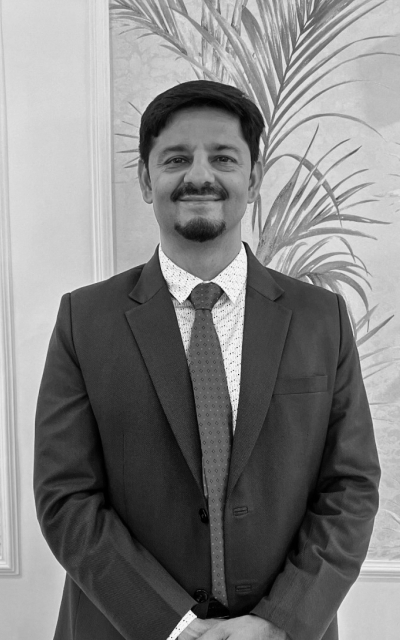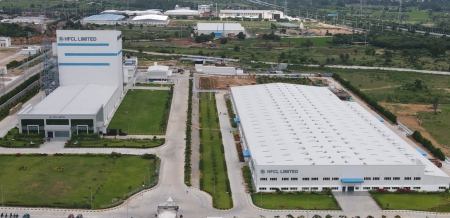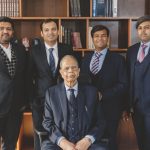Since its inception as a telecom equipment manufacturer in 1987, HFCL has diversified its product portfolio over the years to establish itself as a technology solutions provider. HFCL is focused on strategic initiatives of expanding their India and global business with increased investments in R&D, developing margin accretive new products and doing vertical integration in both, backward and forward directions. Currently, the company has invested heavily for the expansion of optical fibre capacity from 12 million fibre kilometers (fkm) to 33 million fkm and in optical fibre cables capacity expansion from current 25 million fkm to 30 million fkm. With a focus on growth and innovation, HFCL invested INR 177.21 crores for R&D in 2023. In a recent interaction with Wire & Cable India, Mr. Harsh Pagay, Executive President – Optical Fibre & Optical Fibre Cable, HFCL, shared his views on the optical fibre cable industry and talked in detail about the company’s journey, growth, and future plans.
Wire & Cable India: Please share your views on the optical fibre cable industry.
Harsh Pagay: With rapid digital adoption, we are witnessing a growing relevance for optical fibres and optical fibre cables in the industry. Fibre optics are serving as the backbone for various technologies including 5G and its use cases, STDC, broadband, and even 6G which is now being widely talked about. However, the cyclic nature of this industry, marked by periods of growth and decline, was facing its share of challenges and temporary slowdown due to the geopolitical issues which have now started showing signs of recovery.
In India, the BharatNet initiative has already completed Phase-1 and Phase-2 since its inception in 2014. The government has also approved INR 40,000 crores for Phase-3 which positions the telecom industry for renewed growth, expecting OFC demand of approximately 40 million fkm over the next 3 years. Even international markets like the US have indicated positive market recovery. President Joe Biden also recently outlined substantial funding to each state which is expected to start flowing mid-2024. Despite the current slowdown, we are anticipating a return to the previous market levels within a few quarters.
As to address the global deployment of 5G, the network’s widespread adoption still remains in its early stages due to its prominent dependence on emerging technologies such as AI/ML, AR/VR, metaverse, and blockchain. To address this challenge, efforts are being made by industry bodies and government agencies to accelerate the development of these technologies and foster the growth of 5G use cases. Once the use cases materialize and 5G monetization picks up pace, the datacenter industry will witness substantial growth. In tandem, optical fibre cables will play a crucial role in carrying, storing, and transferring data. HFCL has thus strategically invested in fibre expansion initiatives to cater to the demand from hyperscaling datacenters.
WCI: Kindly tell us about HFCL, its journey, the current scenario, and its core expertise.
HP: HFCL started its journey as a telecom equipment manufacturer in 1987. Over a period of time, the company evolved to strategically expand its business operations and product portfolio through a lot of vertical integration, both backward and forward. In the decades to follow, HFCL’s optical fibre cable business took the center stage. We became the leading manufacturer of optical fibres and optical fibre cables in India. We then further ventured into system integration, development of various 5G and transport equipment, Wi-Fi products and solutions, deploying optical fibre cables for various networks, telecom operators, agencies as well as for the railways, and defense sectors.
Throughout our journey, we have focused on addressing our customers’ pain points by offering them innovative solutions and customized products that not only resolve network deployment challenges but also provide them cost benefits. Our customer-centric approach forms the basis of the strategy for HFCL’s growth.
As one of the prominent technology companies in India for system integration, HFCL is recognized for its innovative offerings in three key areas: optical fibre products (including optical fibres, optical fibre cable, and connectivity), 5G products, and 5G access points. By delivering innovative products in these domains, we empower them to expand their networks and enhance their service offerings.
Watch: RR Kabel | Solar Cables | Solar Plant | Renewable Energy
WCI: What are HFCL’s top strategic priorities?
HP: As India’s technological progress in the telecom sector has positioned it as an attractive global investment and manufacturing destination, HFCL is also deeply committed to significantly contribute in this vision and emerge as the leading technology player in the global markets. In order to meet this goal, our strategic emphasis is on expanding capacity, reaching new geographical markets, transitioning revenue from projects to products, integrating backward and horizontally, dedicating to robust R&D, and creating profitable new products. We are actively pursuing this vision by leveraging our domain expertise, technological strengths and established market presence across domains like optical fibre cables, 5G access products, Wi-Fi and transport equipment.
Expanding capacities: HFCL has invested heavily on the expansion of optical fibre capacity from 12 million fkm to 33 million fkm and optical fibre cables capacity expansion from current 25 million fkm to 30 million fkm as part of their expansion plans.
Revenue mix: Over the next three years, we’re targeting a significant increase in product revenue from 56% to 70%, backed by substantial investments in research and development for diverse products in both domestic and international markets.
Strengthening global footprint and focus on revenue from international markets: With our focus to capitalise on wide global opportunities and boost revenue from international operations, we are actively developing new product portfolios as per international standards, appointing employees, engaging agents and distributors in key international markets like The UK, The US, Middle East and Africa.
Development of next-gen products and solutions: In pursuit of staying at the forefront of innovation and next-generation technological capabilities, HFCL had launched a comprehensive suite of next-gen technologies including 5G FWA CPE, IP MPLS routers, 2T2R 5G small cell, and 1728-high fiber IBR optical fiber cable at IMC 2023.
With an unyielding focus on delivering value to our shareholders, we are confident that our strategy will continue to enhance our revenues and profitability in the coming years.
WCI: You had so many product launches happening during IMC. Please tell us about your current product range and new developments with regard to the new products and solutions developed for the industry.
HP: In a sector where telecom equipment and Wi-Fi access point standards are paramount, we are well positioned to understand the unique nature of our customer requirements. HFCL tailor made products are specific to each customer’s needs introducing new features, enhancing applicability, and reducing overall cost. In response to the evolving nature of the industry, HFCL launched some innovative 5G solutions and backhauling products during the India Mobile Congress 2023 9 and 12-fibre count cables which are particularly popular in data centres among carriers and hyperscalers. Our focus on miniaturization has also led us to introduce some of the world’s smallest micro cables
HFCL’s product offering for fiberisation spans over an entire spectrum of optical fibres that are indigenously manufactured and produced in-house at our Hyderabad facility. Certified by TEC in India and Telcordia in the US, these optical fibres include the G652D and bend-insensitive G657A1 fibres which address last-mile connectivity. We have also developed a smaller version, i.e. 200 micron fibres for G652D, G657A1 and G657A2 fibre which are crucial for our next-generation cable products.
Further diversifying into HFCL’s cable products, we offer a comprehensive range of traditional products including armored, aerial, tech, and micro cables for telecom operators and customers in the domestic market. Parallely, we are also working aggressively to develop revolutionary products, like Intermittently Bonded Ribbon (IBR) cables, lower-diameter micro cables, and micro module cables, which are prominently in demand in European markets. Additionally, we have last-mile connectivity cables, drop cables, smaller drop cables, and individual fibres, which are tailor made for telecom operators worldwide.
Also Read: Group Nirmal: A Legacy of Innovation & Excellence
WCI: Apart from 1728 fiber count IBR cable, please share information about the other 5G connectivity and backhauling products launched during India Mobile Congress 2023.
HP: India Mobile Congress 2023 witnessed HFCL’s groundbreaking strides in 5G connectivity and backhauling solutions. Apart from the remarkable 1728 high-fiber count IBR cable, we also unveiled a suite of next-generation connectivity products and solutions including 5G FWA (Fixed Wireless Access) CPE (Customer Premise Equipment), IP MPLS Routers, and 2T2R 5G small cell.
In order to address the last-mile connectivity challenge in key global markets, HFCL introduced the first ‘Made-in-India’ 5G FWA CPE portfolio. The range spanning both indoor and outdoor 5G FWA CPEs across multiple frequency bands, is built to complement wired broadband connections in areas where fibre rollout is limited. HFCL’s 5G FWA CPE supports both 5G SA and NSA technologies across multiple Sub-6 GHz and mmWave frequency bands to offer cost-effective and fibre-like speeds to customers using the 5G network.
HFCL also launched IP MPLS Routers to empower telcos to backhaul 5G networks, fibre broadband networks and provide last mile connectivity to enterprises in urban metros and tier 2 cities. These IP MPLS Routers are capable of handling different types of data traffic, support Quality of Service (QoS) for bandwidth prioritization and avoid network congestion.
These innovative launches at India Mobile Congress 2023 reinforces our commitment to driving technological advancements, meeting industry needs, and establishing HFCL as a leader in next-gen technology solutions. These offerings will play a vital role in advancing India’s connectivity landscape and meeting the demands of a rapidly digitizing economy.
“HFCL has invested heavily on the expansion of optical fibre capacity from 12 million fkm to 33 million fkm and optical fibre cables capacity expansion from current 25 million fkm to 30 million fkm as part of their expansion plans.”
WCI: Please tell us about your manufacturing setup, and the kind of capacities, and technological capabilities. How are you placed as compared to your peers globally?
HP: We have four manufacturing facilities in Goa, Chennai, Hosur, and Hyderabad to manufacture optical fibres and optical fibre cables. Emphasizing on our vertical integration, we also manufacture some raw materials for cable manufacturing ourselves.
Our current fibre capacity is 12 million fkm which we draw at the Hyderabad factory and we are working towards expanding this capacity to 33 million fkm. This project is already underway with the first phase expected to complete by July 2024, bringing our capacity to 25 million fkm. The second phase of the project is due to complete by June 2025, when our total fibre capacity will be 33 million fkm, one of the highest in India. In optical fibre cables, our current capacity is 25 million fkm sourced from our manufacturing units in Goa, Chennai, and Hyderabad. This is set to increase to 30 million fkm within the next six months due to our ongoing expansions. Further expansion projects which are in the conception phase will potentially raise our optical fibre cable capacity to 35-40 million fkm within a year from now.
In terms of HFCL’s product offerings, we have developed some next-generation products for international markets as well including Europe, the US, and the UK. Led by our CTO, Dr. Peter Weimann, our team has been working aggressively to develop tailored products that offer unique application, compact design, and competitive pricing, enabling us to target new global markets and reach the majority of tier-one telecom operators.
WCI: What is your USP? Would you like to add something on the technology side like the technical capabilities of HFCL?
HP: As a technology-driven enterprise, HFCL is highly focused on developing innovative and futuristic technology products. In order to meet all kinds of customer requirements, we are designing and developing locally yet robust and next-gen technology products and solutions. Like 1728 high-fiber count IBR cable, which is the latest technology in optical fibre cables and further developing different versions of this technology and enhancing its capacity too. It is one of the key products that we launched at IMC 2023 that is suitable for hyperscalers, datacenters and is also becoming very popular with carriers. In the US, many carriers are using these IBR cables in their back-on and trunk applications. We have already got some orders from telecom operators, tier 1 telecom operators, and international operators. Apart from that, we have also developed different variants of cables offering last-mile connectivity solutions. We offer multiple variants of low-diameter cables like 200 microns, 190 microns, and 180 microns, which we have developed in our Hyderabad factory. The in-house manufacturing enables us to attract good yields. Apart from that, we are also working on fibre sites to lower the attenuation.
We also have our in-house NABL approved testing facilities to test the performance of micro cables and other OFCs including the blowing performance of the cables in a microduct for blowing distances and blowing speeds in simulated field conditions. We have different equipment for different field conditions simulations, like extreme temperatures, galloping and aeoline simulation for aerial cable installations. The in-house testing enables us to develop new products that are ahead of time and our competitors, and offer great value to our customers.
WCI: What is the philosophy of the company with regard to R&D and what kind of efforts do you actually put on the ground for it?
HP: With a focus on our strategy – New Products, New Customers, and New Geographies, HFCL has aggressively invested in R&D to indigenously design and develop various offerings, including L2 switches, enhanced Wi-Fi 6 access points and improved efficiency point-to-point and point-to-multipoint UBRs amongst other products and solutions. In FY23, HFCL had invested INR 177.21 crores in R&D.
In our R&D facility located in Bangalore, we have a dynamic team of 200 highly qualified engineers from prestigious institutions such as IITs, NIITs, and holding advanced degrees, including M-Tech and PhDs who are at the forefront of innovation. We also take pride in a diverse workforce, with one in every three engineers in our Bangalore team being a woman. Together, they are dedicated to pioneering advancements in 5G technology, Wi-Fi access points and routers.
As a customer-centric technology company, we work closely with our customers and develop customized products to meet their networking needs. Prototyping, manufacturing, and testing are all conducted in our own factory.
Following rigorous testing, we provide the prototypes to our customers for their evaluation and field trials. Upon successful completion of these trials, we proceed with the official launch of the cables. This collaborative approach to R&D has resulted in a diverse product portfolio, spanning a wide range of cables.
“With a focus on our strategy – New Products, New Customers, and New Geographies, HFCL has aggressively invested in R&D. In FY23, HFCL had invested INR 177.21 crores in R&D.”
WCI: Kindly tell us about your market footprint.
HP: HFCL ranks among India’s top optical fiber cable manufacturers, signifying our substantial industry position. We were among the key suppliers of cables during BharatNet phases 1 and 2. We have been a partner of choice of all key telcos and government bodies and have significantly contributed in shaping up India’s telecommunications sector. Apart from the Indian market, from the past five to six years, we have shifted our focus now more on building our international business as well. Our managing director, Mr. Mahendra Nahata has defined HFCL’s transformation strategy as ‘New Market, New Geographies, and New Products’ and we are aggressively pursuing this with the development of various innovative, next-gen products, reaching out to new customers, and exploring global markets. We have supplied our products to more than 60-70 countries, having a strong market share in Europe, the UK, Australia, the Middle East, and Africa. In the past year, we have focused our efforts on the US market anticipating significant growth in the future. We have employed a team in the US market on new product development, sales, and marketing. We aim to boost our export revenue from the current 35 percent to approximately 70-80 percent.
WCI: What according to you are the challenges and opportunities that are present in the OFC industry?
HP: With the increased focus on digital transformation in the Indian market, there has been exponential growth in digital infrastructure like development and strengthening of digital payment systems, UPI, DigiYatra, DigiLocker, and ONDC, and further many new digital public infrastructure projects are also being undertaken by the Government. This has resulted in the increased demand for high-speed connectivity driving innovation and investment in the sector. As there is a growing thrust from the government on capex, I believe that India will soon be among one of the top 5G ecosystems in the entire world. BharatNet is one of the key initiatives started by the government with the vision of creating a digital highway, providing internet connectivity to everyone, including those living in remote areas of India. Therefore, in order to bridge this existing digital divide, participation from various technology and telecom players become crucial. Despite the volatility in the global economy in the last 10 years, the Indian economy has witnessed a promising growth trajectory. In line with this upward trajectory, India has set a very ambitious target for itself of emerging as a USD 5 trillion digital economy by 2025. However, if we have to sustain this kind of growth, then the efforts for the development of these technologies should be accelerated, and all the policy decisions that the government has made should be implemented expeditiously. For example, the huge gap between the BharatNet 2 tender and the BharatNet 3 tender should have been reduced. Such decisions will definitely be able to sustain this growth and we will be able to achieve the government targets of a USD 1 trillion digital economy by 2025.






